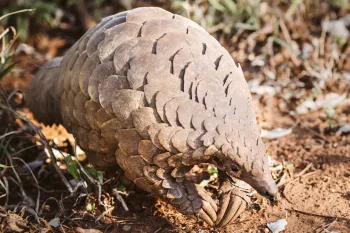Stuffed in a sports bag in Johannesburg, South Africa, the small pangolin was far from her natural environment. She’d been poached from her home and held without food or water for around 10 days, and now she was up for sale. In February 2020, wildlife traffickers brought her to an arranged meeting with a buyer.
Luckily for her, this was not a transaction; it was actually an intelligence-driven sting operation organized by the African Pangolin Working Group with local law enforcement agencies. The operation resulted in one of the traffickers receiving a three-year jail sentence or a fine.
Shortly after the rescue, Nicci Wright—wildlife project manager of Humane Society International/Africa, director of the Johannesburg Wildlife Veterinary Hospital and co-chairperson of the African Pangolin Working Group—received a call letting her know the pangolin was on the way.
In 2017, HSI/Africa joined efforts led by the wildlife hospital and the working group to rehabilitate and release pangolins rescued from the illegal wildlife trade. Pangolins are the most trafficked mammal in the world; their scales are used in traditional medicine and their meat for human consumption. Currently, all eight species of pangolins—four in Africa and four in Asia—are threatened with extinction.
On a global scale, HSI advocates for increased enforcement of the wildlife trade to curtail pangolin poaching and trafficking. HSI has also implemented behavior change campaigns to reduce demand for pangolin products. On the ground, the rehabilitation program—a collaboration among groups—helps boost the wild pangolin population.
Adam Parker/Manyoni Private Game Reserve
In early 2020, the rescued pangolin found in a sports bag—a 2-year-old Temminck’s pangolin nicknamed Cory—joined the program.
When Cory first arrived at the Johannesburg Wildlife Veterinary Hospital, she was dehydrated and emaciated. Wright says wildlife traffickers rarely give pangolins water while they are held in captivity. Some traffickers might offer food, but the animals still go hungry without the ants and termites they eat in the wild. These quiet, shy creatures also experience vast distress. The terror they endure “makes them dehydrated and then lowers their immune system, which allows all sorts of infections,” says Wright.
At the hospital, Cory was anesthetized by veterinarian Dr. Karin Lourens and given an intravenous rehydrating drip and a tube to provide easily digestible liquid food. She weighed less than 11 pounds and needed to gain almost 4 pounds before she could survive in the wild. Cory then went to an off-site, secure pangolin ward to recover and sleep, something rescued pangolins sorely need after days or weeks living in fear, says Wright. Pangolins spend up to three days in intensive care before venturing outdoors with a dedicated pangolin walker to eat ants and termites for a few hours each day.
After a month, Cory was ready for a “soft release” into the wild. Thanks to funding by the Zululand Conservation Trust, she was transported to Manyoni Private Game Reserve, located in the South African province KwaZulu-Natal, where Temminck’s pangolins have been locally extinct for around four decades.
She’s totally fine on her own, and it’s beautiful to see her so strong and wild and normal.
Leno Sierra, African Pangolin Working Group
During the day, Cory enjoyed long walks around the reserve under the watchful eye of Leno Sierra, Zululand field manager for the working group. These walks helped Cory acclimate and create her own territory while rescuers monitored her progress. At night, she stayed in a secure shelter. Pangolin reintroduction is a very “long, slow process,” says Wright; the animals must learn to find food and avoid predators in a new environment.


